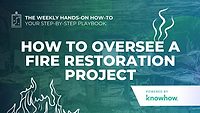Weekly Hands-on How-To powered by KnowHow
How To Operate a HEPA Vacuum
A Step-by-Step Guide for Operating a HEPA Vacuum for Safe and Efficient Cleaning

Image provided by KnowHow.
Whether you’re working in mold remediation, post-construction cleanup, or disaster recovery, a HEPA vacuum is an essential tool for getting the job done safely and efficiently. Its powerful filtration system doesn’t just clean up what’s visible; it captures the microscopic contaminants that could otherwise linger in the air and jeopardize your work environment.
But using a HEPA vacuum effectively requires more than plugging it in and pressing "go." Proper setup, operation, and maintenance are critical to ensuring it performs at its best—and that your team stays protected from exposure to harmful particles. In this week’s how-to, powered by KnowHow, we’ll guide you step-by-step through mastering the HEPA vacuum, from pre-operation checks to post-cleaning care.
Get ready to clean smarter, not harder, and let’s get into this one!
Note: This Weekly Hands-On How-To was based on this template in KnowHow’s template library.
Step 1: Conduct a Pre-Operation Safety Check
Before starting, it’s essential to ensure the HEPA vacuum is in optimal condition. A thorough safety check reduces the risk of malfunctions, ensures the equipment operates at peak efficiency, and protects the work environment from further contamination. Neglecting this step could compromise the vacuum’s performance and your team’s safety.
- Inspect the Vacuum: Examine the entire unit, including the power cord, for any damage or missing parts that could hinder operation.
- Ensure Filter Integrity: Verify the HEPA filter is securely installed and free of damage to maintain effective filtration.
- Empty the Tank: Clear out any leftover debris from previous use to maximize storage capacity and avoid blockages during operation.
Step 2: Set Up the HEPA Vacuum
Setting up the HEPA vacuum properly is critical to achieving efficient and safe results. A well-prepared vacuum minimizes downtime and ensures thorough dust and debris removal. Taking the time to assemble and test the equipment correctly will save time and frustration later.
- Assemble the Unit: Attach hoses, extensions, and additional tools firmly. Make sure the waste collection bag or canister is secured.
- Test Power and Suction: Plug the vacuum into a grounded outlet and briefly power it on to check for any issues, such as weak suction or strange noises.
- Adjust Settings: Select the appropriate power level and settings based on the type of material you’ll be collecting. Start on low settings for delicate jobs to reduce dust disturbance.
Step 3: Operate the HEPA Vacuum Safely
Operating the HEPA vacuum requires more than just turning it on and vacuuming. A careful approach ensures thorough cleaning and minimizes strain on the equipment. Proper technique protects both the user and the environment, especially in sensitive areas.
- Turn On the Vacuum: Switch on the main power and adjust suction for optimal performance.
- Cleaning: Begin vacuuming at the farthest point of the area and work methodically towards the exit to avoid retracing steps.
- Avoid Overloading: Use attachments to handle large debris and prevent blockages or unnecessary wear on the motor.
- Empty as Needed: Periodically check and empty the waste container, especially during high-contamination jobs, to maintain strong suction power.
- Power Down Safely: Turn off and unplug the vacuum before starting any maintenance or relocating it to a new area.
Step 4: Perform Post-Use Maintenance
After completing your cleaning tasks, post-use maintenance ensures the HEPA vacuum remains ready for future use. Skipping this step can lead to degraded performance and shorter equipment lifespan. Regular maintenance protects your investment and enhances safety on the next job.
- Clean the Exterior and Attachments: Wipe down the vacuum’s surface and all hoses and tools to remove dirt and grime.
- Inspect and Replace Filters: Check for clogged or damaged filters, replacing them as needed to maintain efficiency.
- Store Properly: Neatly coil the power cord and store the vacuum in a clean, dry space away from moisture and sunlight to prevent damage.
Master the Tools, Empower Your Team, Lead the Response
Whether you’re tackling construction dust or dealing with hazardous contaminants, proper operation and maintenance of this tool are key to achieving the best results. But even the most reliable tools require skilled operators.
Ensuring your team understands every step, from setup to post-use maintenance, can make all the difference in job performance and client satisfaction. That’s where KnowHow comes in. By providing clear, step-by-step guidance and on-the-job training tools, KnowHow empowers your team to work confidently and efficiently every time.
Visit tryknowhow.com today to see how KnowHow can support your team with the tools and knowledge they need to confident and competent on any job site.
Looking for a reprint of this article?
From high-res PDFs to custom plaques, order your copy today!








